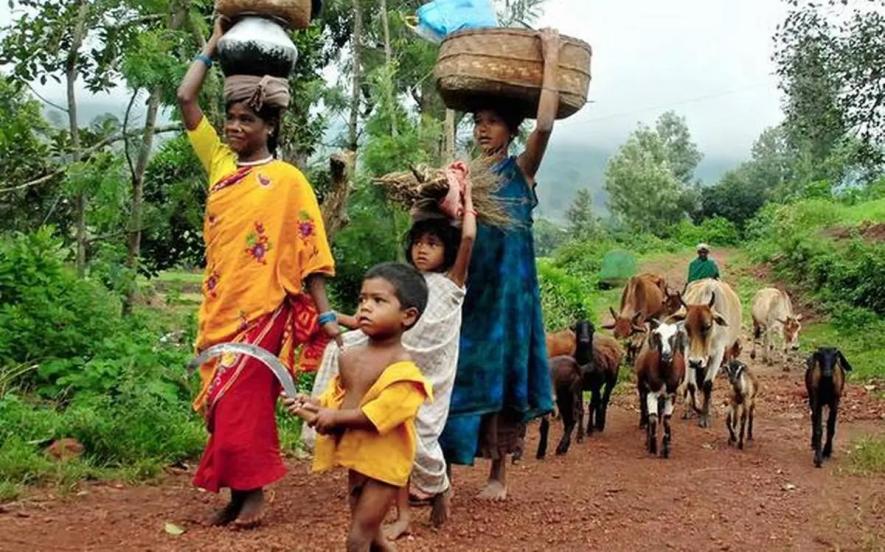Are Over 1,10,000 Adivasis & Forest Dwellers at Risk of Eviction and Loss of Livelihood?

Ignoring the law that stresses that original inhabitants, traditional forest dwellers and Adivasis must not be evicted from Tiger Reserves, the MoEFCC, has recently simply stated that they will be rehabilitated so that they do not lose their traditional livelihood. No details on any modalities have, however, been provided.
During the ongoing Budget session of the Parliament, a list of questions was raised by Lok Sabha member Anubhav Mohanty from Biju Janata Dal regarding the country’s Tiger Reserve Forest (s) enquiring about:
(a) the number of Tiger Reserve Forests in the Country along with the number of Tigers;
(b) whether all the Tiger Reserve Forests fulfil the criteria fixed to be declared as Tiger
Reserve Forest; and
(c) the number of forests going to be declared as Tiger Reserve Forests
However, the most crucial question raised by Mohanty to the Minister of State in the Ministry of Environment, Forest and Climate Change was about the manner in which the Government proposes to “rehabilitate” the inhabitants of such areas in such a fashion as to enable them to continue earning their traditional livelihood. To this Mr. Ashwini Choubey’s written answer read, “The Government of India through ongoing Centrally Sponsored Scheme of Project Tiger provide funding support for voluntary village relocation and rehabilitation of people from core areas of Tiger Reserves apart from facilitating convergence with other schemes of Government departments ensuring alternate livelihood support”.
What’s concerning here is that the minister’s response does not really answer the question. The answer merely informs that the government proposes to rehabilitate the inhabitants of the forest but does not explain the manner in which they propose to do so. The Wildlife Protection (Amendment) Act 2006 gives as much importance to the conservation of the tribal people and their livelihood as much it does to the conservation of tigers.
Article 38-O of the said Act (amended) is clear. The Tiger Conservation Authority may issue binding directions for the protection of tiger or tiger reserves but no such direction shall interfere with or affect the rights of local people particularly the Scheduled Tribes.
Article 38-O Powers and functions of Tiger Conservation Authority-
(2) The Tiger Conservation Authority may, in the exercise of its powers and performance of its functions under this Chapter, issue directions in writing to any person, officer or authority for the protection of tiger or tiger reserves and such person, officer or authority shall be bound to comply with the directions: Provided that no such direction shall interfere with or affect the rights of local people particularly the Scheduled Tribes.
Section 38V (4) also states that while notifying an area as a Tiger Reserve, the TCA shall “ensure the agricultural, livelihood, developmental and other interests of the people living in tiger bearing forests or a tiger reserve.” Under Section 38V 3 (b), too “livelihood concerns of local peoples” has been mentioned and protected.
38V Tiger Conservation Plan. -
(4) Subject to the provisions contained in this Act, the State Government shall, while preparing a Tiger Conservation Plan, ensure the agricultural, livelihood, developmental and other interests of the people living in tiger bearing forests or a tiger reserve.
Moreover, the definition of “Tiger Reserve” includes “core or critical tiger habitat areas of National Parks and sanctuaries, where it has been established, on the basis of scientific and objective criteria, that such areas are required to be kept as inviolate for the purposes of tiger conservation, without affecting the rights of the Scheduled Tribes or such other forest dwellers, and notified as such by the State Government in consultation with an Expert Committee constituted for the purpose”.
The answer dated March 21, 2022 may be read here:
Theory vs. Reality
While in theory, the Government maybe providing funding support for “voluntary” village relocation and rehabilitation of people, the reality may well be different. According to 2006 estimates of the Ministry of Environment and Forests there were 1487 villages with a population of 3.80 lakhs in just the 28 tiger reserves of which 273 villages and 1.1 lakh people lived in what the Ministry calls the “core” area, that is the area in which according to the Ministry there should be no human habitation for the needs of tiger conservation. In the adjacent “buffer” area also substantial numbers of tribal families had their rights to livelihood seriously restricted causing great distress.
In Chattisgarh, the State Government had to go to the Supreme Court in an appeal to permit tribals and local communities living in 313 villages in the 15 protected areas in the State the right to collect at least minor forest produce which is the basis of their livelihood. This was because, the Ministry for Environment (MOEF) --as a result on an earlier Supreme Court order ---did not permit even plucking of leaves or collection of honey in any protected area of the State. This despite the fact that there was nothing to show, no data, or environmental impact study that the collection of minor forest produce would adversely affect bio-diversity conservation concerns.
Most of the wildlife sanctuaries are in tribal dominated Vth schedule areas. But in none of these sanctuaries have the claims of tribals been settled and in many they are considered encroachers to be evicted. The situation remains more or less the same in sanctuaries all over the country where tribals face eviction or are banned from collection of minor forest produce which is their livelihood. Many of the forests declared protected areas are in the Vth and VIth Scheduled Protected areas where there are very specifically delineated rights of self-governance for tribals recognized by law as for example under the Panchayat Extension to Scheduled Areas Act 1996 but which are being violated.
These amendments to the Wildlife Protection Act, 1972 were passed before the Scheduled Tribes and Other Traditional Forest Dwellers (Recognition of Forest Rights) Act, 2006 that draws strength from the Indian Constitution and as much as we understand “our” law we need to know that the Wildlife Protection Act of 1972 was also amended to recognise the inherent rights of Adivasis and Forest Dwellers.
Get the latest reports & analysis with people's perspective on Protests, movements & deep analytical videos, discussions of the current affairs in your Telegram app. Subscribe to NewsClick's Telegram channel & get Real-Time updates on stories, as they get published on our website.
























